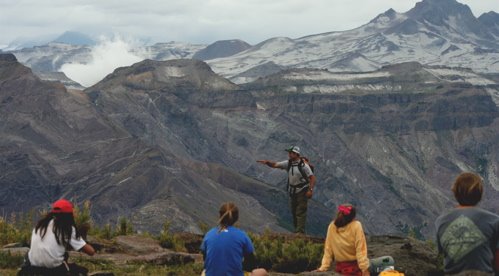 I noticed the first signs of damage from the 8.8 earthquake while waiting to pass through customs in the Santiago airport. Tiles had been removed from the ceiling to check for structural damage and spider-vein cracks climbed the walls. The car rental department had been moved outside of the airport into huts while construction crews worked to repair portions of the building.
I noticed the first signs of damage from the 8.8 earthquake while waiting to pass through customs in the Santiago airport. Tiles had been removed from the ceiling to check for structural damage and spider-vein cracks climbed the walls. The car rental department had been moved outside of the airport into huts while construction crews worked to repair portions of the building.As we drove south on Ruta 5, distancing ourselves from Santiago we saw increasing signs of damage. Bridges were separated from their foundations, and were either down completely, or supported by scaffolding. A few detours were set up around the most damaged bridges and a few chunks were missing from the roads, but other than that travel remained easy and smooth as we drove to Curico, home to our 3 Chilean alumni.

We spend the afternoon checking in on friends, and the orphanage we work with, CONIN--all of whom are safe, and whose structures suffered only minor damage from the quake. We spoke with Joyce, the headmaster of Orchard College to get the contact information of a few rural schools who needed help. We then picked up two Alzar School alumni, Rosario and Titi, from school and got to work organizing over 200 lbs of school supplies into individual packets of supplies for the 90 students in these rural schools.

We met her down the road in a nearby small town. This school housed 40 students before the quake, but suffered significant damage, and were now setting up desks on the basketball court as all the classrooms were unusable. While the court was covered with an aluminum roof, the teachers were very concerned about the coming winter. Winter brings cold temperatures to this town and lots of rain. The basketball court is not enclosed, is at a low point on the property, and usually has about 1-2’’ of standing water when it rains. We knew the supplied we had, and the funds Alzar School students had worked so hard to raise, would be put to good use in this town.
After a tour of the facilities and seeing the extensive damage, we presented the headmaster with about 100 lbs of school supplies and about $500 to use for the repairs of the building. The teachers
We drove another two hours to a coastal town, Boyeruca, which had been hit not only by the earthquake, but also by the tsunami that followed. Along the way we got a flat tire (story of our life in Chile), and stared out the window at the destruction we passed (the vast majority of the rural structures were compromised). We could see the surf before we could see the town, and knew that we were going to see an entirely different type of destruction in this town. As we arrived you could see debris along the hillside where high-water had crashed into the shore. The elementary/middle school was one of the first buildings in town. We were greeted by the headmaster, Freddie, outside what had been the front of 
A large water container was outside of the school along with a port-a-john, as no running water was coming to the town. We had enough individual school supply bags for each of the students, as well as some classroom supplies and funds we left with the teachers. I am not a construction expert, but it wouldn’t surprise me if this school needed to be leveled, and reconstructed from scratch.
I was so proud to be able to go down to the country which has been a second home to us, and share support from Alzar School Alumni. Upon my return I spoke with my father, who went to Haiti after their earthquake to perform surgeries in a make-shift hospital. We compared experiences, and both felt like it wasn’t going to be any one act that “saves” anything. It is the collective actions of so many, and continued support that is going to make a difference.
Thank you to everyone who donated, and supported the cause. Alzar School will go back to each of these schools in December this year on our Rivers of Chile 2011 trip. We will be in contact with them to hear about progress between now and then and learn more about how we can help when we return.

No comments:
Post a Comment